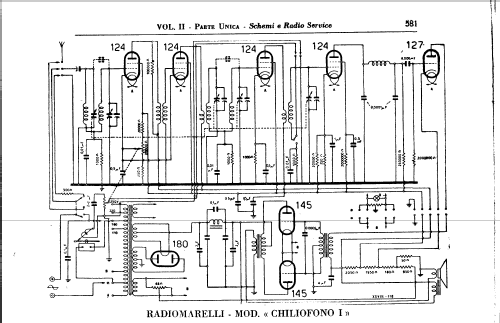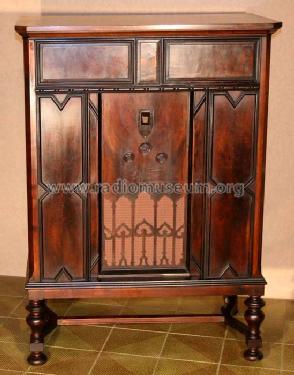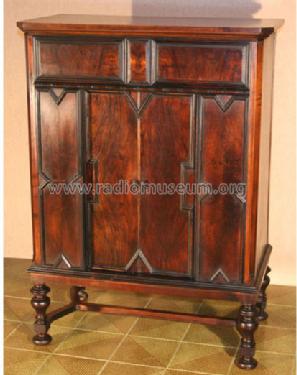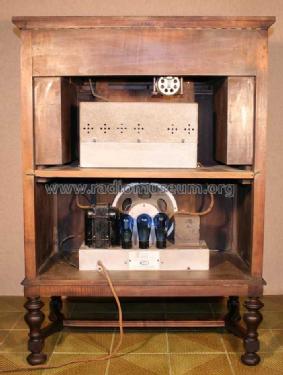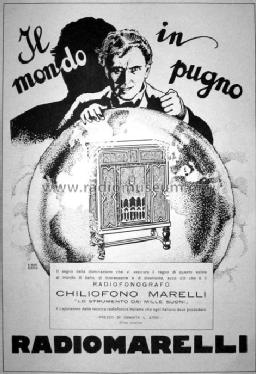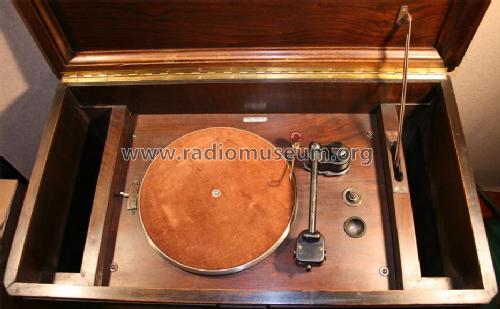Chiliofono I (1)
Marelli (Radiomarelli); Sesto San Giovanni (MI)
- Country
- Italy
- Manufacturer / Brand
- Marelli (Radiomarelli); Sesto San Giovanni (MI)
- Year
- 1931/1932
- Category
- Broadcast Receiver - or past WW2 Tuner
- Radiomuseum.org ID
- 73916
Click on the schematic thumbnail to request the schematic as a free document.
- Number of Tubes
- 8
- Wave bands
- Broadcast only (MW).
- Details
- Record Player (not changer)
- Power type and voltage
- Alternating Current supply (AC) / 110; 160; 220; 250 Volt
- Loudspeaker
- Electro Magnetic Dynamic LS (moving-coil with field excitation coil)
- Material
- Wooden case
- from Radiomuseum.org
- Model: Chiliofono I - Marelli Radiomarelli; Sesto
- Shape
- Console, Lowboy (legs < 50 %).
- Dimensions (WHD)
- 800 x 1100 x 445 mm / 31.5 x 43.3 x 17.5 inch
- Price in first year of sale
- 3,700.00 ITL
- Source of data
- Guida Pratica Antique Radio II (2000)
- Mentioned in
- La moderna Supereterodina, Ravalico, 1938 (pag. 371)
- Literature/Schematics (1)
- -- Original prospect or advert
- Literature/Schematics (2)
- -- Schematic (La Riparazione degli Apparecchi Radio, Delforno - Colciago, Italy 1941)
- Author
- Model page created by Alessandro De Poi. See "Data change" for further contributors.
- Other Models
-
Here you find 488 models, 378 with images and 300 with schematics for wireless sets etc. In French: TSF for Télégraphie sans fil.
All listed radios etc. from Marelli (Radiomarelli); Sesto San Giovanni (MI)
Collections
The model Chiliofono I (1) is part of the collections of the following members.
Forum contributions about this model: Marelli Radiomarelli: Chiliofono I
Threads: 1 | Posts: 1
Dear all,
in the Forum thread ‘Old capacitor marking’ Prof. Dietmar illustrated several non-conventional volume control circuits used in the early age of the radio. This review recalled me the strange solution I found in the model ‘Chiliofono’, produced in Italy by Radiomarelli, in the very late twenties. This huge TRF receiver used a voltage divider, from the screen grid voltage (about 120VDC) to ground, to give a positive bias to the cathodes of the first two RF amplifier stages. The volume control is encircled in the diagram below. Considering the combined action of the cathode currents and of the current flowing from the power supply, the DC voltage on both cathodes roughly varied from 2V to 40V. The result was similar to the grid bias illustrated by Prof. Dietmar in the circuit of Fig. 172, the transconductance of the tubes decreasing when the positive cathode voltage was increased. The relatively high current passing in the volume control potentiometer asked for a wirewound type. By the way, the radio used a double section potentiometer, the second section wired as a variable attenuator on the phono pick-up.

in the Forum thread ‘Old capacitor marking’ Prof. Dietmar illustrated several non-conventional volume control circuits used in the early age of the radio. This review recalled me the strange solution I found in the model ‘Chiliofono’, produced in Italy by Radiomarelli, in the very late twenties. This huge TRF receiver used a voltage divider, from the screen grid voltage (about 120VDC) to ground, to give a positive bias to the cathodes of the first two RF amplifier stages. The volume control is encircled in the diagram below. Considering the combined action of the cathode currents and of the current flowing from the power supply, the DC voltage on both cathodes roughly varied from 2V to 40V. The result was similar to the grid bias illustrated by Prof. Dietmar in the circuit of Fig. 172, the transconductance of the tubes decreasing when the positive cathode voltage was increased. The relatively high current passing in the volume control potentiometer asked for a wirewound type. By the way, the radio used a double section potentiometer, the second section wired as a variable attenuator on the phono pick-up.

Emilio Ciardiello, 21.Nov.07
